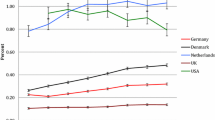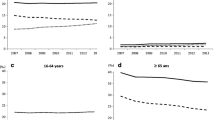Abstract
Little is known about antipsychotic prescription patterns among children and adolescents in Japan, particularly in outpatient settings. We investigated the prevalence and trends of antipsychotic prescription for outpatients aged ≤ 17 years receiving a first antipsychotic prescription from 2006 to 2012 based on a large-scale dispensation dataset. Measurements included age, sex, department of diagnosis and treatment, type of prescription (monotherapy or polytherapy), antipsychotic dosage, and concomitant psychotropic drugs. Of the 10,511 patients, 65.1% were aged 13–17 years, and 52.9% were males. Second-generation antipsychotic monotherapy prescriptions increased from 53.8% in 2006 to 78.3% in 2012. Risperidone was the most frequently prescribed antipsychotic, followed by aripiprazole and olanzapine. Approximately 25.0% of patients were prescribed an initial dose less than recommended. Second-generation antipsychotic monotherapy is currently the most frequent prescription pattern among outpatients aged ≤ 17 years receiving an initial antipsychotic prescription.





Similar content being viewed by others
References
Japanese Society of Neuropsychopharmacology (2021) Guideline for pharmacological therapy of schizophrenia. Neuropsychopharmacol Rep 41(3):266–324
Rothenberger A, Roessner V (2019) Psychopharmacotherapy of obsessive-compulsive symptoms within the framework of tourette syndrome. Curr Neuropharmacol 17(8):703–709
Sharma SR, Gonda X, Tarazi FI (2018) Autism spectrum disorder: classification, diagnosis and therapy. Pharmacol Ther 190:91–104
Jerrell JM, Tripathi A, Rizvi AA, McIntyre RS (2012) The risk of developing type 2 diabetes mellitus associated with psychotropic drug use in children and adolescents: a retrospective cohort analysis. Prim Care Companion CNS Disord 14(1):PCC.11m01185
Leucht S, Cipriani A, Spineli L, Mavridis D, Orey D, Richter F et al (2013) Comparative efficacy and tolerability of 15 antipsychotic drugs in schizophrenia: a multiple-treatments meta-analysis. Lancet 382(9896):951–962
Divac N, Prostran M, Jakovcevski I, Cerovac N (2014) Second-generation antipsychotics and extrapyramidal adverse effects. Biomed Res Int 2014:656370
Schneider C, Corrigall R, Hayes D, Kyriakopoulos M, Frangou S (2014) Systematic review of the efficacy and tolerability of clozapine in the treatment of youth with early onset schizophrenia. Eur Psychiatry 29(1):1–10
Pillay J, Boylan K, Newton A, Hartling L, Vandermeer B, Nuspl M et al (2018) Harms of antipsychotics in children and young adults: a systematic review update. Can J Psychiatry 63(10):661–678
Kumra S, Oberstar JV, Sikich L, Findling RL, McClellan JM, Vinogradov S et al (2008) Efficacy and tolerability of second-generation antipsychotics in children and adolescents with schizophrenia. Schizophr Bull 34(1):60–71
Stafford MR, Mayo-Wilson E, Loucas CE, James A, Hollis C, Birchwood M et al (2015) Efficacy and safety of pharmacological and psychological interventions for the treatment of psychosis and schizophrenia in children, adolescents and young adults: a systematic review and meta-analysis. PLoS ONE 10(2):e0117166
National Institute for Health and Care Excellence (2013) Psychosis and schizophrenia in children and young people: Recognition and management [CG155]. https://www.nice.org.uk/guidance/cg155. Accessed 1 Oct 2020
National Institute for Health and Care Excellence (2019) Depression in children and young people: Identification and management in primary, community and secondary care [NG134]. https://www.nice.org.uk/guidance/ng134. Accessed 1 Oct 2020
Okumura Y, Fujita J, Matsumoto T (2014) Trends of psychotropic medication use among children and adolescents in Japan data from the national insurance claims database between 2002 and 2010. Seishin Shinkeigaku Zasshi 116:921–935
Satoh M, Obara T, Nishigori H, Nishigori H, Ooba M et al (2016) Prescription trends in children with pervasive developmental disorders: a claims data-based study in Japan. World J Pediatr 12:443–449
Ronsley R, Scott D, Warburton WP, Hamdi RD, Louie DC, Davidson J et al (2013) A population-based study of antipsychotic prescription trends in children and adolescents in British Columbia, from 1996 to 2011. Can J Psychiatry 58(6):361–369
Pringsheim T, Lam D, Patten SB (2011) The pharmacoepidemiology of antipsychotic medications for Canadian children and adolescents: 2005–2009. J Child Adolesc Psychopharmacol 21(6):537–543
Goddard AW, Schwartz K, Hendrix K, Aalsma MC, Slaven J, Hancock EF et al (2016) Trends in use and cost of second-generation antipsychotics among children and teens in Indiana Medicaid, 2004–2012. Psychiatr Serv 67(9):1030–1034
Hartz I, Skurtveit S, Steffenak AK, Karlstad O, Handal M (2016) Psychotropic drug use among 0–17 year olds during 2004–2014: a nationwide prescription database study. BMC Psychiatry 16:12
Chee KY, Tripathi A, Avasthi A, Chong MY, Xiang YT, Sim K et al (2016) Prescribing pattern of antidepressants in children and adolescents: findings from the research on Asia Psychotropic Prescription Pattern. East Asian Arch Psychiatry 26(1):10–17
Chon MW, Lee J, Chung S, Kim Y, Kim HW (2017) Prescription pattern of antidepressants for children and adolescents in Korea based on nationwide data. J Korean Med Sci 32(10):1694–1701
Tsai CY, Yang HC, Islam M, Hsieh WS, Juan SH, Chen JC et al (2017) Psychotropic medications prescribing trends in adolescents: a nationwide population-based study in Taiwan. Int J Qual Health Care 29(6):861–866
KRAFT Inc. http://www.kraft-net.co.jp/. Accessed 1 Oct 2020
Japan Medical Institute Co., Ltd. http://www.jpmedri.co.jp/. Accessed 1 Oct 2020
Ain Pharmaciez Inc. http://www.ainj.co.jp/. Accessed 1 Oct 2020
Urushihara H, Kobayashi S, Honjo Y, Kosugi S, Kawakami K (2014) Utilization of antipsychotic drugs in elderly patients with Alzheimer’s disease in ambulatory practice in Japan. Science 1(1):e00014
Kochi K, Sato I, Nishiyama C, Tanaka-Mizuno S, Doi Y, Arai M, Fujii Y, Matsunaga T, Ogawa Y, Furukawa TA, Kawakami K (2017) Trends in antipsychotic prescriptions for Japanese outpatients during 2006–2012: a descriptive epidemiological study. Pharmacoepidemiol Drug Saf 26(6):642–656
Onishi Y, Hinotsu S, Furukawa TA, Kawakami K (2013) Psychotropic prescription patterns among patients diagnosed with depressive disorder based on claims database in Japan. Clin Drug Investig 33(8):597–605
Inagaki A, Inada T (2012) Dose equivalence of psychotropic drugs. Part XXIII: dose equivalence of novel antipsychotics: paliperidone extended release. Jpn. J. Clin. Psychopharmacol 15(3):397–404
IBM Corp (2013) IBM SPSS statistics for windows. IBM Corp, Armonk, NY. https://hadoop.apache.org.
Okumura Y, Noda T, Ito H (2013) Antipsychotics prescribing patterns of patients with schizophrenia in Japan: using the national database of health insurance claim information and specified medical checks. Jpn J Clin Psychoparmacol 16:1201–1215
Bachmann CJ, Lempp T, Glaeske G, Hoffmann F (2014) Antipsychotic prescription in children and adolescents: an analysis of data from a German statutory health insurance company from 2005 to 2012. Dtsch Arztebl Int 111(3):25–34
Bachmann CJ, Roessner V, Glaeske G, Hoffmann F (2015) Trends in psychopharmacologic treatment of tic disorders in children and adolescents in Germany. Eur Child Adolesc Psychiatry 24(2):199–207
Verdoux H, Pambrun E, Cortaredona S, Tournier M, Verger P (2015) Antipsychotic prescribing in youths: a French community-based study from 2006 to 2013. Eur Child Adolesc Psychiatry 24(10):1181–1191
Crystal S, Mackie T, Fenton MC, Amin S, Neese-Todd S, Olfson M et al (2016) Rapid growth of antipsychotic prescriptions for children who are publicly insured has ceased, but concerns remain. Health Aff (Millwood) 35(6):974–982
Piovani D, Clavenna A, Bonati M (2019) Prescription prevalence of psychotropic drugs in children and adolescents: an analysis of international data. Eur J Clin Pharmacol 75(10):1333–1346
Piovani D, Clavenna A, Cartabia M, Bonati M (2016) Psychotropic medicine prescriptions in Italian youths: a multiregional study. Eur Child Adolesc Psychiatry 25(3):235–245
Ito H, Koyama A, Higuchi T (2005) Polypharmacy and excessive dosing: psychiatrists’ perceptions of antipsychotic drug prescription. Br J Psychiatry 187:243–247
Yoshio T, Inada T, Uno J, Miwa T, Kitagawa K, Miyahara Y et al (2012) Prescription profiles for pharmacological treatment of Japanese inpatients with schizophrenia: comparison between 2007 and 2009. Hum Psychopharmacol 27(1):70–75
Olfson M, Blanco C, Liu SM, Wang S, Correll CU (2012) National trends in the office-based treatment of children, adolescents, and adults with antipsychotics. Arch Gen Psychiatry 69(12):1247–1256
Hálfdánarson Ó, Zoëga H, Aagaard L, Bernardo M, Brandt L, Fusté AC et al (2017) International trends in antipsychotic use: a study in 16 countries, 2005–2014. Eur Neuropsychopharmacol 27(10):1064–1076
Ichikawa H, Mikami K, Okada T, Yamashita Y, Ishizaki Y, Tomoda A et al (2017) Aripiprazole in the treatment of irritability in children and adolescents with autism spectrum disorder in Japan: a randomized, double-blind, placebo-controlled study. Child Psychiatry Hum Dev 48(5):796–806
Kirino E (2014) Profile of aripiprazole in the treatment of bipolar disorder in children and adolescents. Adolesc Health Med Ther 5:211–221
American Psychiatric Association (2021) The American Psychiatric Association practice guideline for the treatment of patients with schizophrenia, Third edition
Nassar N, Dixon G, Bourke J, Bower C, Glasson E, de Klerk N et al (2009) Autism spectrum disorders in young children: effect of changes in diagnostic practices. Int J Epidemiol 38(5):1245–1254
Sato K, Tanba S, Inoue S (2008) Guideline for schizophrenia treatment. The Second editorial. Igaku-Shoin Ltd
Acknowledgements
We acknowledge Ain Holdings Inc. and Kraft Inc. for the generous provision of pharmacy claims data. We thank Jennifer Barrett, Ph.D., from Edanz Group for editing a draft of this manuscript.
Funding
This study was supported by the Sponsored Research Program administered by Kyoto University and Sumitomo Dainippon Pharma.
Author information
Authors and Affiliations
Corresponding author
Ethics declarations
Conflicts of interest
Sayuri Nakane, Sachiko Tanaka-Mizuno, Madoka Yamamoto-Sasaki, Masato Takeuchi, Chika Nishiyama, and Yusuke Ogawa declare that they have no conflicts of interest. Kenji Kochi is an employee at Sumitomo Dainippon Pharma. has received honoraria from Eli Lilly. Toshiaki A. Furukawa reports grants and personal fees from Mitsubishi-Tanabe, personal fees from MSD, grants and personal fees from Shionogi, outside the submitted work; In addition, TAF has a patent 2020-548587concerning smartphone CBT apps pending, and intellectual properties for Kokoro-app licensed to Mitsubishi-Tanabe. Koji Kawakami has received research funds from Eisai Co. Ltd.; Kyowa Kirin Co. Ltd.; Sumitomo Dainippon Pharma Co. Ltd.; Pfizer Inc.; Stella Pharma Corporation; CMIC Co. Ltd.; Suntory Beverage & Food Ltd.; Mitsubishi Corporation, and Real World Data Co. Ltd.; consulting fees from LEBER Inc.; JMDC Inc.; Shin Nippon Biomedical Laboratories Ltd.; Kaken Pharmaceutical Co. Ltd.; and Advanced Medical Care Inc.; executive compensation from Cancer Intelligence Care Systems; Inc.; honorarium from Mitsubishi Chemical Holdings Corporation, Mitsubishi Corporation, and Pharma Business Academy; and holds stock in Real World Data Co. Ltd..
Ethical Approval
This study was approved by the Ethics Committees of Kyoto University Graduate School of Medicine (registration number E1897). All procedures were conducted according to the Declaration of Helsinki. In addition, all procedures performed in studies involving human participants were following the ethical standards of the institutional and national research committee and with the 1964 Helsinki declaration and its later amendments or comparable ethical standards.
Additional information
Publisher's Note
Springer Nature remains neutral with regard to jurisdictional claims in published maps and institutional affiliations.
Rights and permissions
About this article
Cite this article
Nakane, S., Tanaka-Mizuno, S., Nishiyama, C. et al. Trends in Prescribing Antipsychotics for Children and Adolescents in Japan: A Descriptive Epidemiological Study Using a Large-Scale Pharmacy Dataset. Child Psychiatry Hum Dev 54, 1250–1257 (2023). https://doi.org/10.1007/s10578-022-01330-x
Accepted:
Published:
Issue Date:
DOI: https://doi.org/10.1007/s10578-022-01330-x




